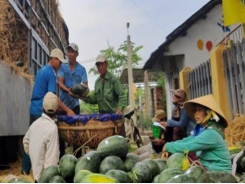Mekong Delta summer – autumn rice output to go up slightly: authorities

Ho Chi Minh City – The Cửu Long (Mekong) Delta, the country’s rice granary, will see summer – autumn rice output increase by 150,000 tonnes this year, the Plant Cultivation Department has estimated.
Farmers harvest rice planted under the smart rice farming model in Hậu Giang Province’s Vị Thủy District. – VNA/VNS Photo Duy Khương
Output is expected to be 8.95 million tonnes.
Farmers in the delta have already harvested 1.05 million hectares with an average yield of 5,700 kilogrammes per hectare, up 100kg from last year.
The delta expects to complete harvesting 1.57 million hectares by early next month.
In Đồng Tháp Province, farmers have harvested about 70 per cent of the crop.
Nguyễn Phước Thiện, deputy director of its Department of Agriculture and Rural Development, said the average yield would be 6,050kg per hectare.
Lê Thanh Tùng, deputy head of the Plant Cultivation Department, said the delta has enjoyed favourable factors this year.
The floods were less severe and the rainfall was less and came later than in previous years, he explained.
So the harvest has not been affected by floodwaters and late rains would not damage the crop, he said.
The crop has not been affected by drought or saltwater intrusion either.
The Ministry of Agriculture and Rural Development has recommended that the delta’s 12 provinces and Cần Thơ City should grow the upcoming autumn - winter rice crop on 750,000ha marginally more than last year.
In Đồng Tháp and An Giang, the delta’s upstream provinces, farmers do not grow the third rice crop in many localities to enable release of floodwaters into rice fields to kill pathogens and improve soil fertility.
Đồng Tháp has encouraged farmers to replace rice with other high-value crops on low-yield fields.
Farmers who grow lotus earn VNĐ50 – 100 million (US$2,155 – 4,310) per hectare, two or three times the income from rice.
Authorities across the delta encourage farmers to grow high-quality rice varieties and adopt farming models that use advanced farming techniques or are meant to adapt to climate-change such as rice – shrimp farming.
Cà Mau Province has instructed farmers who rotate between rice and shrimp farming on the same field to grow high-quality rice varieties that are resistant to saltwater this rainy season.
The high-quality varieties include OM 5451, OM 6162, Camau 1, Camau 2, ST20, and ST24.
The province plans to have 38,000ha under the model this rainy season, with 500ha being to organic standards.
The province Department of Agriculture and Rural Development is establishing tie – ups between various players in the production chain of specialty rice varieties ST 20 and ST 24, which are planted on 5,000ha in Thới Bình, U Minh and Trần Văn Thời districts and Cà Mau City.
Có thể bạn quan tâm
Phần mềm

Phối trộn thức ăn chăn nuôi

Pha dung dịch thủy canh

Định mức cho tôm ăn

Phối trộn phân bón NPK

Xác định tỷ lệ tôm sống

Chuyển đổi đơn vị phân bón

Xác định công suất sục khí

Chuyển đổi đơn vị tôm

Tính diện tích nhà kính

Tính thể tích ao hồ



 Vietnamese export products face stricter non-tariff barriers in…
Vietnamese export products face stricter non-tariff barriers in…  Organic agriculture production is inevitable trend
Organic agriculture production is inevitable trend